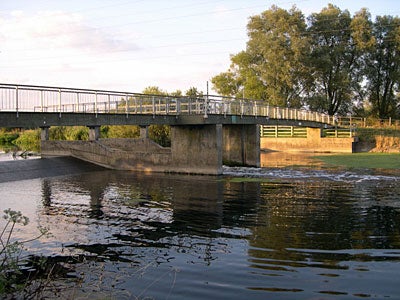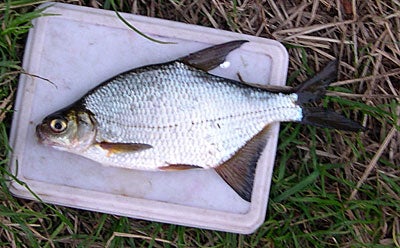| MARK WINTLE |
| Mark Wintle, an angler for thirty-five years, is on a quest to discover and bring to you the magic of fishing. Previously heavily involved with match fishing he now fishes for the sheer fun of it. With an open and enquiring mind, each week Mark will bring to you articles on fishing different rivers, different methods and what makes rivers, and occasionally stillwaters, tick. Add to this a mixed bag of articles on catching big fish; tackle design, angling politics and a few surprises. Are you stuck in a rut fishing the same swim every week? Do you dare to try something different and see a whole new world of angling open up? Yes? Then read Mark Wintle’s regular column. |
| BUMBLEBEE’S WONDER BAIT That artful old codger Professor Bumblebee, CE at Tart Tackle, recently got in touch. “When are you going to try out these brilliant new products from Tart Tackle?” He asked. “I’ve got the new rod, reel, floats and best of all a phenomenal new bait. Just meet me at Throop one evening, you just bring a landing net, hooks, shot and those sort of sundries, oh, and don’t forget to bring a camera for all the specimens that you’ll catch.” How could I refuse?
Two days later I met him at Throop. We went to the New Weir where he unveiled the latest offerings from Tart Tackle. “Just look at this rod. 1.2 ounces”. It looked remarkably like a thirty year old ABU Mark 6 to me, and felt like it too. “Twelve ounces more like.” I replied, wondering how we coped all those years ago. Perhaps I was about to find out again as it was the only rod available. The reel he produced looked remarkably familiar too. An old ABU 506. At least it was loaded with decent line. “Why does the float have ‘Ivan Marks’ printed on it?” I enquired. “Oh stop fussing, mere camouflage in case any Tickle Tackle spies should see the underlying quality and realise what we’re up to, and get tackled up. You’ll be amazed at the results with this gear, and will be wondering why you bother with your modern rubbish. Anyway, wait till you try this remarkable new bait – Flayck. Only £ 2.99 for three slices which compares favourably to those pots of hookable pellets that you buy at the same price.” “Then why does it come in a Kingsmill wrapper?” I replied. I was well and truly hung out to dry. All I could do was tackle up the ancient ensemble, and hope for the best. I didn’t even have anything to groundbait with. Peering down from the footbridge revealed plenty of roach, all sizes from an ounce or two up to a pound plus. There was even a good bream of about five pounds feeding on the weed. I set up the little Pacemaker float with a BB shot under the float, two no. 1 shot above the hooklength, and a no. 4 dropper eight inches above a size fourteen hook. Back to Reality What follows is a true account of less than three hours fishing. I did have a few old maggots with me, and actually started with a twenty hook. This attracted minnows in the edge but out in the main pool I had a couple of dace fairly quickly. I then changed to the fourteen hook and began to fish with pinches of flake. To my left there was about four feet of water over the concrete sill which then dropped into about six feet. Here and there clumps of weed were present. At first casting was awkward, and I struggled to get any distance. The rig needed careful feathering to get it to land gently in a straight line. The slow action of the rod was simply different to modern carbon but with half an hour’s practice I managed to obtain accuracy and distance. The dotted down tip of the float was certainly sensitive, and it all came flooding back why this particular range of floats had been a favourite all those years ago. It behaves differently to the sticks and crow quill Avons that I use nowadays but its effectiveness in the right circumstances cannot be doubted. I shall have to give these floats more of an airing.
After those initial dace on maggots, I started to pick up nice roach on bread; these ranged from about three ounces up to ten ounces, plump fish grown fat on the silkweed of the weir sill. But it was a fish I struck into after an hour or so that was the first pleasant surprise. It felt strange playing a big fish on this rod though it coped well enough. The friction of the old ABU was unwelcome as the line eased around the angles of the pickup cup. With a bit of careful steering around the weedbeds I soon had the fish in the net. A splendid bream of about five pounds. Tangles, tangles, tangles… As the light started to drop so what little wind there had been also went. This had been slightly in my face, and caused a succession of tangles inside the reel behind both the winding cup and the spool. The weight of rod began to tell as well. I can remember being virtually unable to move my shoulder after six hour matches spent trotting for dace on fast rivers. Then, as the light began to fade I caught a second bream, this one a little smaller than the first. The roach had grown wary of my constant casting though I had a few more, and I ended the evening with two small silver bream.
There were silver bream in the old weir pool years ago but I hadn’t realised there was still a population of them in this area. I had one three weeks ago on pellet, so maybe there are more around than is immediately obvious (they probably can’t manage 14mm Halibut pellets!). There are all sorts in the weir pool; in the fast water there are sometimes barbel, and carp and pike often appear. Just before I packed up, a small shoal of perch herded a shoal of minnow in right into the edge, creating mayhem as they struck. It had been an interesting session. I’d forgotten how effective bread can be on the Stour in summer. I tend to think of it as a winter bait on most of the Stour, believing that the many tiddlers are too much of a nuisance in summer to make it worth using. That may be true some of the time but not always. Is it the rod, or the angler? Though it’s easy to sneer at the clumsiness of rods like the Mark 6, at the time it came out in 1972, it was simply the best. There was even a waiting list at one time such was the demand. I used one from 1974 to 1978 but then changed to a Bruce and Walker XLS, and shortly afterwards my first carbon rod. But during those five years using this rod, I caught my first two-pound roach, big chub and barbel, and won many matches, even broke a match record. It still works, and it remains true that it isn’t the rod that catches the fish. It has limitations, but then it was designed as a rod for float fishing with light lines. I stuck with the ABU 506 for much less time. I had an ABU 505 from 1973 to 1975, and bought this reel for a song about that time, but then I changed to Mitchell Matches in 1976, and never really went back to closed face reels. In this session I had numerous tangles behind the bail cup and spool, something partly cured by better spools. The line bedded in all too easily after playing a big fish, and playing a big fish was far from satisfactory due to all those angles. I’m not sure the drag ever worked properly. “Flayck” is obtainable at supermarkets and corner shops everywhere, from 15p to a £ 1, take your pick, white, brown, wholemeal… |
















